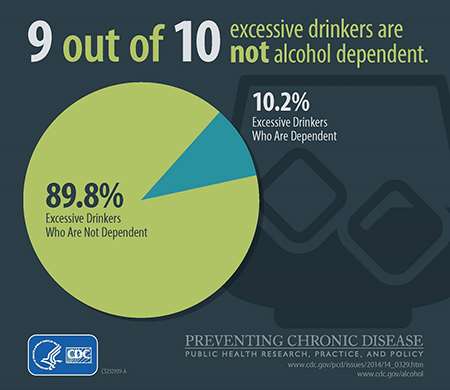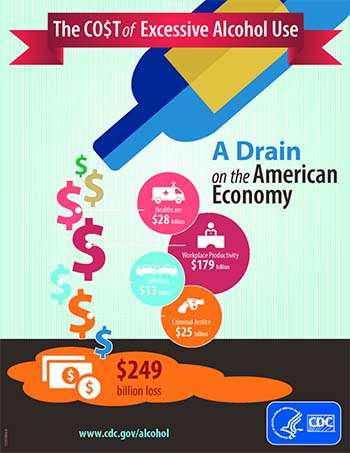Understanding the Problem of Excessive Alcohol Use
 Excessive alcohol use is a significant threat to the health, safety, and prosperity of Wisconsin’s residents. Unfortunately, every county in Wisconsin has high rates of excessive alcohol use. Defined as binge, heavy drinking, underage drinking and drinking while pregnant, the impact of excessive alcohol use ripples throughout society and negatively impacts the economy. Wisconsin’s alcohol issues are not just the result of those individuals diagnosed with alcohol use disorders – 9 out of 10 excessive drinkers are not alcohol dependent (see right).
Excessive alcohol use is a significant threat to the health, safety, and prosperity of Wisconsin’s residents. Unfortunately, every county in Wisconsin has high rates of excessive alcohol use. Defined as binge, heavy drinking, underage drinking and drinking while pregnant, the impact of excessive alcohol use ripples throughout society and negatively impacts the economy. Wisconsin’s alcohol issues are not just the result of those individuals diagnosed with alcohol use disorders – 9 out of 10 excessive drinkers are not alcohol dependent (see right).
By working together, we can understand the factors that have created the excessive drinking rates. By using research, data and evidence, communities can implement policies and practices that prevent and reduce excessive alcohol use without inconveniencing moderate adult drinkers.
Formed to support communities and decision-makers, the Wisconsin Alcohol Policy Project (WisAPP) studies Wisconsin’s trends and supports communities in making positive change by identifying local alcohol-related issues and the policies to address them. Together, we can ensure communities are healthy, safe, thriving and enjoyable to all.
Alcohol Issues and Health
According to the Centers for Disease Control (CDC), excessive drinking is associated with numerous health problems. There are significant short- and long-term health impacts of binge, heavy drinking, underage drinking and drinking while pregnant. Because in Wisconsin every county exceeds the national average of excessive drinking, the Wisconsin Alcohol Policy Project (WisAPP) focuses on strategies to reduce excessive alcohol use by working with coalitions and local health departments as well as civic, religious, health care, local government, and state government agencies to make positive change.
Short-term risks of excessive alcohol use include:
- Memory problems in young adults
- Alcohol poisoning
- Unintentional injuries, such as motor-vehicle traffic crashes, falls, drowning, burns, and firearm injuries
- Violence, such as child maltreatment, sexual assault, suicide and homicide
- Harm to a developing fetus if a woman drinks while pregnant, such as miscarriages, stillbirth and fetal alcohol spectrum disorders
- Increased cancer risk in:
- Breast
- Head and neck including larynx, mouth and throat
- Esophagus
- Liver
- Colon
- Rectal
Longer-term impacts include increased risks of:
- High blood pressure, heart disease, stroke, liver disease, and digestive problems
- Weakening of the immune system, increasing the chances of getting sick
- Learning and memory problems, including dementia and poor school performance
- Mental health problems, including depression and anxiety
- Social problems, including family problems, job-related problems, and unemployment
- Alcohol use disorders, or alcohol dependence
Additional Alcohol Health Resources
Alcohol Use and Your Health (CDC)
The CDC has excellent resources to understand what excessive alcohol use is and strategies to make changes in the alcohol environment.
Alcohol's Effects on the Body (NIH)
The National Institute on Alcohol Abuse and Alcoholism has an overview of alcohol’s effects on your body.
Excessive Alcohol Use Information & Resources
-
Binge Drinking
Information about and resources for the prevention of binge drinking.
Learn more -
Heavy Drinking
Information about and resources for the prevention of heavy drinking.
Learn more -
Underage Drinking
Information about and resources for the prevention of underage drinking.
Learn more -
Drinking While Pregnant
Information about and resources to prevent drinking while pregnant.
Learn more
Alcohol Use In Wisconsin
Learn how alcohol impacts people in Wisconsin. Taxpayers are picking up the tab for the excessive drinking issue in Wisconsin. These tools and resources present alcohol use rates, binge drinking rates in every county, youth alcohol use rates and alcohol-related injuries and are updated regularly by the Wisconsin Alcohol Policy Project (WisAPP).
Alcohol Use Nationwide
Learn how Wisconsin compares to the country on alcohol consumption and Surgeon General’s relevant reports.
Wisconsin ranks high in excessive alcohol use compared to the nation. The Milwaukee Journal Sentinel reported that Wisconsin is the only state in the country where every county reported excessive drinking. Excessive alcohol use is responsible for approximately 140,000 deaths in the United States each year and was responsible for $249 billion in economic costs in 2010 alone.
The term “excessive alcohol use” includes:
- Binge drinking (defined as consuming 4 or more alcoholic beverages per occasion for women or 5 or more drinks per occasion for men)
- Heavy drinking (defined as consuming 8 or more alcoholic beverages per week for women or 15 or more alcoholic beverages per week for men)
- Any drinking by pregnant women or those younger than age 21
Explore some of the ways the Wisconsin Alcohol Policy Project (WisAPP) recommends making changes for a healthier state. Feel free to use our tools and to contact us.
Alcohol and Cancer Risk: The U.S. Surgeon General's Advisory
County Health Rankings & Roadmaps: Health Data
Facing Addiction in America: The Surgeon General’s Report on Alcohol, Drugs, and Health (PDF)
Calculating the Alcohol-Related Disease Impact (ARDI)
ARDI is an online application that provides national and state estimates of alcohol-related health impacts, including deaths and years of potential life lost (YPLL).



